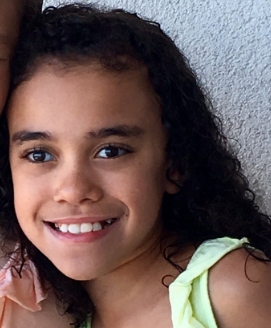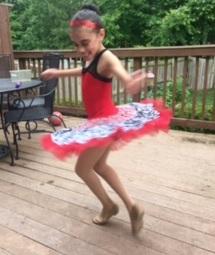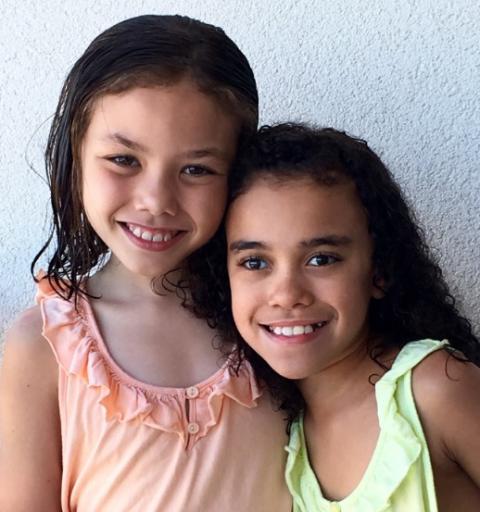Makayla - Our Girl on the Move


“Makayla is the type of kid who has amazing energy that will overtake the room,” remarks her mother, Shannon. Makayla is 11 years old and lives in southern United States with her mother, father, and younger sister, Ariana. “She is always going at 150 miles per hour,” says Shannon, “and will ask you a million questions like, ‘How old are you?’ ‘Are you married?’ ‘Do you have a pet?’ She wants to know it all.” She has a big personality and is very empathetic. Makayla just loves people, and when Shannon brings her to school and they walk through the halls, everyone knows her and says hello. Shannon knows that Makayla feels loved.

Shannon is reflective about her family’s life with Makayla in the earlier years. She remembers her and her husband just making it through the day and being content to have her safe at home. Makayla had a lot of health issues and behaviors, which made daily life more difficult. However, after a while they came to the realization, “Why shouldn’t she be doing all the things other children are doing? Let’s not cap her; let’s try it all and get her to reach her fullest potential.” The family made a conscious decision to get outside of their comfort zone and create a well-rounded life for Makayla. At this time they sought out adaptive programs and let Makayla’s interests expand. They knew some things wouldn’t work and that she wouldn’t like some of them, but they needed to try. This is when Makayla started to thrive.
One of the characteristics of Smith-Magenis Syndrome (SMS) is having a circadian rhythm that cycles at the wrong time. Makayla’s nights and days are inverted and because of this, nights are difficult. Even with sleep medication Makayla often wakes up in the night, and when she is awake, she is ready to play! Her sleep cycles affect her days at school and her overall moods, as she is truly sleep deprived. She spends 2 hours a day in a regular education classroom, and the other 4 hours in special education. This combination has been successful in supporting her sensory, educational, and behavioral needs. One-on-one supports at school and at home help keep Makayla safe. A consistent behavior intervention plan is also helpful. Makayla’s current teacher is very flexible and gets creative with her, which makes a world of a difference. Shannon tries to help teachers understand Makayla by telling them, “Imagine how you feel on your worst days when you’ve been up for nights and now your clothes feel like sandpaper on your body, and multiple demands and deadlines are being placed on you.” That seems to help them support Makayla appropriately to be regulated and safe, and meet her sensory needs.
Supports on Makayla’s IEP include the ability to take a nap during the day, leave the room to take a break, and take sensory breaks as needed. Her teacher and a one-on-one aid help her stay regulated and safe. Makayla is starting to use some self-regulation strategies on her own, which we are so proud of. She really loves engaging in helping tasks at school, such as putting the flag up every morning. If Makayla is getting distressed about lining up, the teacher might say, “Can you help me bring this book to the next classroom?” This helps regulate her stress and transition her to the next activity; distraction and redirection are key.

Makayla receives speech, occupational therapy and physical therapy services. When she first began speech, she used sign language and PECS (Picture Exchange Communication System), and then used a communication device. She used these systems until age 4, when Makayla began to talk, and now at 11 years old she is completely verbal. Speech therapy at school is currently focused on social pragmatics and some articulation. Some motor tasks that are more difficult for Makayla are handwriting and fastening buttons. She continues to work on gross motor skills and this year she learned to swim and ride a bike without training wheels. *Communication with school on Makayla’s medical needs is also important.
When not in school, Makayla stays very busy. She enjoys many sports through an adaptive program called “Jacob’s Chance,” where the children are paired with another child to participate in activities. Through this program she does different sports throughout the year, including basketball, tennis, and soccer. She also participates in “Miracles in Motion” which is an adaptive dance group. Through another program called “Team Impact” she is part of the VCU women’s lacrosse team. At home, Makayla relaxes with her iPad. She loves technology and is good at using it. Shannon notes that Makayla has changed the language on her phone to German!

Shannon sees Makayla as a blessing to their family and they are all changing for the better because of her. She especially sees this in her younger daughter, Ariana (9 years old), who is being shaped by Makayla to be a patient and loving person. When thinking about the future, Shannon feels Makayla may always need supervision, but she wants her to develop skills that enable her to work with people, which she truly enjoys. What Shannon really envisions for Makayla’s future is for her to wake up in the morning and know that she has purpose and meaning.
Advice
Families:
- Life with a child with SMS is doable! Find the supports that you need.
- Leave today as today; wake up and start each new day fresh.
- Keep a constant open line of communication with your family. Shannon has found it valuable to be honest with Ariana about Makayla’s needs and why she will need to spend more time with Makayla sometimes.
- Find support groups. This does not need to be specific to SMS, but she got Ariana connected to other siblings of children with disabilities that she can talk and relate to.
- Give siblings ownership. Ariana went to Makayla’s classroom to teach them about SMS.
Schools and professionals:
- Shannon really emphasizes the importance of working as a team and creating consistency around expectations across different therapies, school, and home.
- Don’t take behaviors personally.
- Flexibility and positivity go a long way.
- Sometimes, Makayla’s emotional responses and behaviors can be lessened with distraction, humor, and redirection.
- Believe in the child. If a strong relationship is formed, they will be eager to impress.
- Don’t think you need to know it all. Connect to other professionals, use resources, and don’t be afraid to ask the family questions.
- Resources:
- The PRISMS website is a great way to learn about SMS
- Recommended book for teachers: On the Road to Success with SMS – A Smith-Magenis Guidebook for School, by Brenda Finucane and Barbara Hass-Givler, which includes recommendations for thinking outside the box when working with children with SMS
*Makayla wears a back brace 18 hours a day for her scoliosis. She also has a hearing aid for her right ear, due to a full hearing loss and glasses to help with vision. Makalya does have absence seizures, which often occur when she is very tired, becoming ill, or when something is hurting her. Makayla cannot feel pain like other children and she could have something that is hurting her, but not realize it. Makayla sees multiple doctors and it is important that her team is aware of changes in medicine and overall medical decisions that will affect her on a daily basis.
